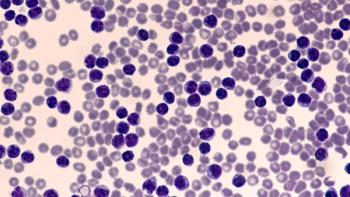
Glofit-GemOx in R/R DLBCL: FDA Advisory Committee Reviews STARGLO Phase 3 Results for Transplant-Ineligible Patients
Key Takeaways
- Glofit-GemOx significantly improved overall survival and progression-free survival in R/R DLBCL patients ineligible for ASCT.
- Safety concerns include cytokine release syndrome, requiring pharmacists to focus on monitoring and supportive care protocols.
Glofitamab combined with GemOx shows promising survival benefits for patients with relapsed DLBCL, offering a new treatment option for those ineligible for transplants.
Relapsed or refractory (R/R) diffuse large B-cell lymphoma (DLBCL) remains a clinical challenge, particularly in patients who are ineligible for autologous stem cell transplant (ASCT). On May 20, 2025, the FDA Oncologic Drugs Advisory Committee (ODAC) convened to discuss the supplemental biologics license application (sBLA) for glofitamab (glofit, Columvi; Genentech) in combination with gemcitabine and oxaliplatin (GemOx) for this patient population. While the committee called for additional data before full endorsement, the clinical results from the STARGLO phase 3 trial (NCT04408638) offer meaningful insights for oncology pharmacists and clinicians managing treatment-refractory aggressive B-cell lymphomas.
STARGLO Trial Overview and Clinical Design
The STARGLO study is a global, randomized, open-label phase 3 trial designed to evaluate the efficacy and safety of glofit in combination with GemOx vs rituximab plus GemOx (R-GemOx) in patients with R/R DLBCL who were ASCT-ineligible or had failed at least 2 prior lines of therapy. The study enrolled 274 patients across 62 sites in 13 countries, including the US, Australia, and several European nations. Notably, the majority of patients (52%) were enrolled outside of Asia, and the trial population was considered reflective of US clinical practice, which was a point of discussion during the ODAC meeting.
Patients were randomized to receive either the investigational combination of glofit-GemOx or the control arm of R-GemOx. The primary end point was overall survival (OS), with key secondary end points including progression-free survival (PFS), objective response rate (ORR), duration of response, and safety and tolerability.
Clinical Efficacy Results
Glofit-GemOx met both its primary and secondary end points, with statistically significant and clinically meaningful improvements in survival outcomes:
- OS: Glofit-GemOx demonstrated a 41% reduction in the risk of death compared to R-GemOx (hazard ratio [HR] = 0.59; 95% CI: 0.40–0.89; P = 0.011). Median OS was 25.5 months for glofit-GemOx, nearly double the 12.9 months observed in the control arm.
- PFS: The combination also showed a 63% reduction in the risk of disease progression or death (HR = 0.37; 95% CI: 0.25–0.55; P < 0.0001).
These efficacy findings mark glofit-GemOx as the first bispecific antibody-based regimen to demonstrate a survival benefit in a phase 3 study of transplant-ineligible patients with R/R DLBCL.
Safety and Tolerability
While the glofit-GemOx combination demonstrated superior efficacy, safety signals were consistent with known profiles of the agents involved:
- Cytokine Release Syndrome (CRS): CRS was observed in 44.2% of patients in the glofit-GemOx arm, with most cases low-grade (grade 1: 31.4%, grade 2: 10.5%, grade 3: 2.3%) and typically occurring in cycle 1.
- Treatment Exposure: Patients in the glofit-GemOx arm received a median of 11 cycles, compared to 4 in the R-GemOx arm, largely due to disease progression in the control group.
- Other Adverse Events: While specific grade 3 or higher hematologic or gastrointestinal toxicities were not detailed in the press release, the safety profile was characterized as consistent with known toxicities of the individual agents.
There may be value in pharmacists paying particularly attention to CRS monitoring protocols, supportive care, and education regarding early signs of immune-related toxicities in patients initiated on this regimen, based on the ODAC sBLA discussion.
Relevance to US Practice and Regulatory Status
Although glofit-GemOx has been approved in more than 30 countries, including under an NCCN Category 1 preferred recommendation in the US for second-line transplant-ineligible DLBCL, the FDA has yet to grant full approval. To address this, the ODAC meeting focused on whether the multiregional STARGLO trial was sufficiently representative of US patients––the committee voted 8 to 1 against the applicability of the patient population and STARGLO trial results. While no biological or clinical distinctions in DLBCL management are recognized globally, the committee expressed interest in additional confirmatory evidence, particularly from US-enrolled subgroups.
"This puts the spotlight on EPCORE DLBCL-4 [NCT06508658] and OLYMPIA-4 [NCT06230224] and what a robust US enrollment would be to ensure applicability of results to a US patient population, which was the point raised in the ODAC,"said Matthew Lei, PharmD, BCOP, clinical pharmacy specialist – lymphoma at Massachusetts General Hospital in Boston and editorial advisory board member for Pharmacy Practice in Focus: Oncology, to Pharmacy Times. "Furthermore, another point raised in the ODAC is applicability of the comparator arm to a US patient population, which for EPCORE DLBCL-4 and OLYMPIA-4 which both are ongoing trials, raises the question on how manufacturers will work with the FDA to address this question."
Glofit monotherapy is already approved in the US for R/R DLBCL following 2 or more prior lines of therapy under accelerated approval, and the STARGLO study is intended to support full approval.
The FDA decision on the sBLA is expected by July 20, 2025.
Pharmacologic Mechanism of Glofit
Glofit is a CD20xCD3 T-cell-engaging bispecific antibody. Its 2:1 format includes 2 CD20-binding domains and 1 CD3-binding domain, bringing T cells into close proximity with malignant B cells to promote immune-mediated cytotoxicity. This design distinguishes glofit from other bispecific antibodies and is thought to contribute to its efficacy in heavily pretreated DLBCL.
Preclinical research suggested synergy between glofit and GemOx, providing the rationale for the combination arm in STARGLO. Gemcitabine and oxaliplatin remain important chemotherapy backbones with broad use in hematologic malignancies, especially where tolerance for more aggressive regimens is limited.
Treatment Implications for Oncology Pharmacists
Pharmacists practicing in both academic and community settings should consider several key implications of these data:
- Fixed-duration, off-the-shelf therapy: Unlike CAR T-cell therapies, which require specialized infrastructure and longer timelines, glofit-GemOx can be administered in outpatient infusion centers with appropriate monitoring—an important feature for patients ineligible for cellular therapies.
- Toxicity Management: CRS, although mostly low grade, requires readiness with antipyretics, corticosteroids, and tocilizumab protocols. Pharmacists play a critical role in protocol development, staff education, and supportive care planning.
- Access and Health System Considerations: Given the fixed-duration and immediate availability of glofit, it may serve as an important bridging or alternative option for patients unable to receive or access CAR T-cell therapy.
- Patient Selection and Monitoring: Appropriate patient selection based on prior lines of therapy, performance status, and transplant ineligibility criteria will be crucial for optimizing outcomes. Pharmacists may contribute to multidisciplinary tumor board discussions, particularly in complex relapsed cases.
Future Directions
Glofit is also being studied in earlier lines of DLBCL, including in combination with polatuzumab vedotin (Polivy; Genentech) and R-CHP in the SKYGLO phase 3 study (NCT06047080).
In the short term, the oncology community awaits full presentation of 2-year follow-up data from STARGLO at the ASCO 2025 Annual Meeting, which may further inform practice patterns and regulatory decision-making.
Conclusion
The STARGLO trial marks a significant advancement in the treatment of transplant-ineligible R/R DLBCL. The combination of glofit with GemOx offers not only a statistically significant survival benefit but also a practical, outpatient-compatible option for a population with limited therapeutic alternatives.
REFERENCE
Roche provides update on FDA Advisory Committee meeting on Columvi combination for people with relapsed or refractory diffuse large B-cell lymphoma. May 20, 2025. Accessed May 20, 2025. https://www.globenewswire.com/news-release/2025/05/20/3085224/0/en/Roche-provides-update-on-FDA-Advisory-Committee-meeting-on-Columvi-combination-for-people-with-relapsed-or-refractory-diffuse-large-B-cell-lymphoma.html
Newsletter
Stay informed on drug updates, treatment guidelines, and pharmacy practice trends—subscribe to Pharmacy Times for weekly clinical insights.




















































































































































































































